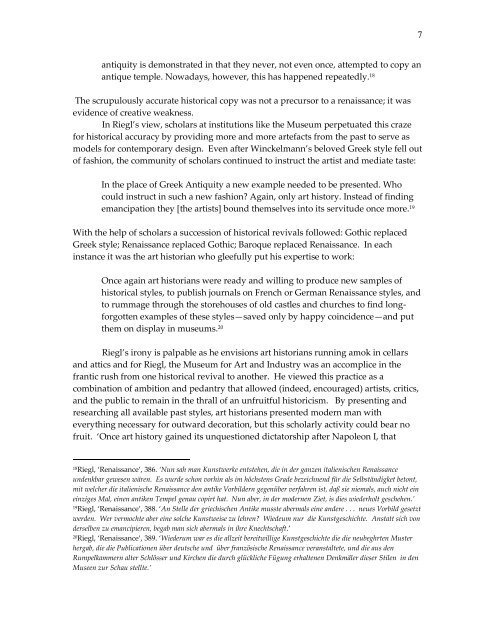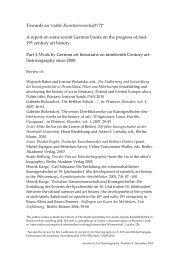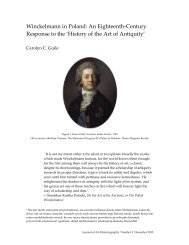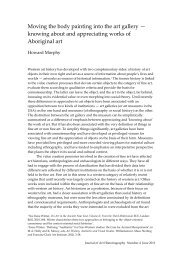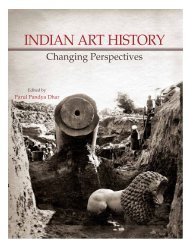The advantages and disadvantages of Art History to Life: Alois Riegl ...
The advantages and disadvantages of Art History to Life: Alois Riegl ...
The advantages and disadvantages of Art History to Life: Alois Riegl ...
Create successful ePaper yourself
Turn your PDF publications into a flip-book with our unique Google optimized e-Paper software.
antiquity is demonstrated in that they never, not even once, attempted <strong>to</strong> copy an<br />
antique temple. Nowadays, however, this has happened repeatedly. 18<br />
<strong>The</strong> scrupulously accurate his<strong>to</strong>rical copy was not a precursor <strong>to</strong> a renaissance; it was<br />
evidence <strong>of</strong> creative weakness.<br />
In <strong>Riegl</strong>’s view, scholars at institutions like the Museum perpetuated this craze<br />
for his<strong>to</strong>rical accuracy by providing more <strong>and</strong> more artefacts from the past <strong>to</strong> serve as<br />
models for contemporary design. Even after Winckelmann’s beloved Greek style fell out<br />
<strong>of</strong> fashion, the community <strong>of</strong> scholars continued <strong>to</strong> instruct the artist <strong>and</strong> mediate taste:<br />
In the place <strong>of</strong> Greek Antiquity a new example needed <strong>to</strong> be presented. Who<br />
could instruct in such a new fashion? Again, only art his<strong>to</strong>ry. Instead <strong>of</strong> finding<br />
emancipation they [the artists] bound themselves in<strong>to</strong> its servitude once more. 19<br />
With the help <strong>of</strong> scholars a succession <strong>of</strong> his<strong>to</strong>rical revivals followed: Gothic replaced<br />
Greek style; Renaissance replaced Gothic; Baroque replaced Renaissance. In each<br />
instance it was the art his<strong>to</strong>rian who gleefully put his expertise <strong>to</strong> work:<br />
Once again art his<strong>to</strong>rians were ready <strong>and</strong> willing <strong>to</strong> produce new samples <strong>of</strong><br />
his<strong>to</strong>rical styles, <strong>to</strong> publish journals on French or German Renaissance styles, <strong>and</strong><br />
<strong>to</strong> rummage through the s<strong>to</strong>rehouses <strong>of</strong> old castles <strong>and</strong> churches <strong>to</strong> find longforgotten<br />
examples <strong>of</strong> these styles—saved only by happy coincidence—<strong>and</strong> put<br />
them on display in museums. 20<br />
<strong>Riegl</strong>’s irony is palpable as he envisions art his<strong>to</strong>rians running amok in cellars<br />
<strong>and</strong> attics <strong>and</strong> for <strong>Riegl</strong>, the Museum for <strong>Art</strong> <strong>and</strong> Industry was an accomplice in the<br />
frantic rush from one his<strong>to</strong>rical revival <strong>to</strong> another. He viewed this practice as a<br />
combination <strong>of</strong> ambition <strong>and</strong> pedantry that allowed (indeed, encouraged) artists, critics,<br />
<strong>and</strong> the public <strong>to</strong> remain in the thrall <strong>of</strong> an unfruitful his<strong>to</strong>ricism. By presenting <strong>and</strong><br />
researching all available past styles, art his<strong>to</strong>rians presented modern man with<br />
everything necessary for outward decoration, but this scholarly activity could bear no<br />
fruit. ‘Once art his<strong>to</strong>ry gained its unquestioned dicta<strong>to</strong>rship after Napoleon I, that<br />
18 <strong>Riegl</strong>, ‘Renaissance’, 386. ‘Nun sah man Kunstwerke entstehen, die in der ganzen italienischen Renaissance<br />
undenkbar gewesen wären. Es wurde schon vorhin als im höchstens Grade bezeichnend für die Selbständigket be<strong>to</strong>nt,<br />
mit welcher die italienische Renaissance den antike Vorbildern gegenüber verfahren ist, daß sie niemals, auch nicht ein<br />
einziges Mal, einen antiken Tempel genau copirt hat. Nun aber, in der modernen Ziet, is dies wiederholt geschehen.’<br />
19 <strong>Riegl</strong>, ‘Renaissance’, 388. ‘An Stelle der griechischen Antike musste abermals eine <strong>and</strong>ere . . . neues Vorbild gesetzt<br />
werden. Wer vermochte aber eine solche Kunstweise zu lehren? Wiedeum nur die Kunstgeschichte. Anstatt sich von<br />
derselben zu emancipieren, begab man sich abermals in ihre Knechtschaft.’<br />
20 <strong>Riegl</strong>, ‘Renaissance’, 389. ‘Wiederum war es die allzeit bereitwillige Kunstgeschichte die die neubeghrten Muster<br />
hergab, die die Publicationen über deutsche und über französische Renaissance veranstaltete, und die aus den<br />
Rumpelkammern alter Schlösser und Kirchen die durch glückliche Fügung erhaltenen Denkmäler dieser Stilen in den<br />
Museen zur Schau stellte.’<br />
7


